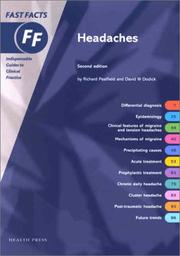| Listing 1 - 3 of 3 |
Sort by
|

ISBN: 1912776014 1903734215 Year: 2002 Publisher: Basel : S. Karger,
Abstract | Keywords | Export | Availability | Bookmark
 Loading...
Loading...Choose an application
- Reference Manager
- EndNote
- RefWorks (Direct export to RefWorks)
The management of people suffering with headaches forms a substantial part of the workload of the family physician and the practising neurologist. While some patients can perform normally using self-medication, headache can be a symptom of a potentially serious illness and disabling headaches, either continuous or as intermittent attacks, require careful assessment and treatment. 'Fast Facts: Headaches' equips the primary care physician with the knowledge required to accurately investigate, assess and treat (or refer) the patient presenting with disabling primary headache. • Enables physicians to distinguish between the benign and potentially life-threatening condition • An expert guide to differential diagnosis • Reviews current processes of assessment, summarises current thinking on pathogenesis and covers management of common forms of disabling headache • Key points are summarised at each chapter-end and clear, simple diagrams and tables support clinical information Contents: • Differential diagnosis • Epidemiology • Clinical features of migraine and tension headaches • Mechanisms of migraine • Precipitating causes • Acute treatment • Prophylactic treatment • Chronic daily headache • Cluster headache; Post-traumatic headache • Future trends

ISBN: 9781912776016 9781903734216 Year: 2002 Publisher: Basel S. Karger
Abstract | Keywords | Export | Availability | Bookmark
 Loading...
Loading...Choose an application
- Reference Manager
- EndNote
- RefWorks (Direct export to RefWorks)
The management of people suffering with headaches forms a substantial part of the workload of the family physician and the practising neurologist. While some patients can perform normally using self-medication, headache can be a symptom of a potentially serious illness and disabling headaches, either continuous or as intermittent attacks, require careful assessment and treatment. 'Fast Facts: Headaches' equips the primary care physician with the knowledge required to accurately investigate, assess and treat (or refer) the patient presenting with disabling primary headache. • Enables physicians to distinguish between the benign and potentially life-threatening condition • An expert guide to differential diagnosis • Reviews current processes of assessment, summarises current thinking on pathogenesis and covers management of common forms of disabling headache • Key points are summarised at each chapter-end and clear, simple diagrams and tables support clinical information Contents: • Differential diagnosis • Epidemiology • Clinical features of migraine and tension headaches • Mechanisms of migraine • Precipitating causes • Acute treatment • Prophylactic treatment • Chronic daily headache • Cluster headache; Post-traumatic headache • Future trends
Book
ISBN: 1003265707 1000602842 1003265707 103220883X Year: 2022 Publisher: Milton Taylor & Francis Group
Abstract | Keywords | Export | Availability | Bookmark
 Loading...
Loading...Choose an application
- Reference Manager
- EndNote
- RefWorks (Direct export to RefWorks)
| Listing 1 - 3 of 3 |
Sort by
|

 Search
Search Feedback
Feedback About UniCat
About UniCat  Help
Help News
News